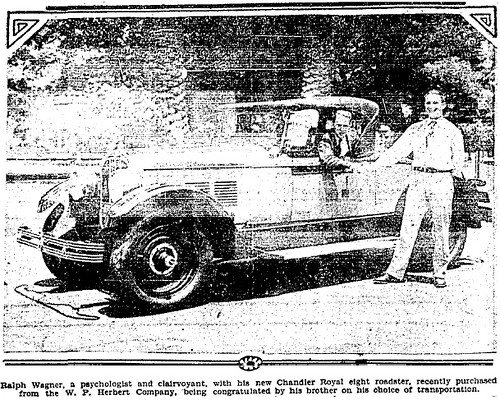
“… Is that its horn sounding
through the night or something darker
that needs to speak? “New Car Blues” – Charles Fishman
Los Angeles
July 23, 1927
World renowned psychologist, astrologer, palm reader, and clairvoyant Ralph Wagner, is shown in the photograph above being congratulated by his brother after purchasing a sporty new Chandler Royal eight roadster.
Mr. Wagner boasts an impressive roster of achievements as a psychic. He foretold the World War back in 1908, and he predicted the recent Weepah gold strike in October of 1926. During the past five years more than 54,000 Angelenos have consulted the palm reader for advice!
Ralph was dazzled by the performance of the vehicle and having read the palms of dozens of Chandler owners, he considered it a great buy, even though at prices ranging from $1495 to $2375 ($17,901.51 to $28,438.85 USD 2007), it was costlier than many other automobiles. Ralph was so passionate about his purchase that he raved, “…after having investigated the stability of the Chandler factory I knew that I was making no mistake in buying a Chandler, for their financial statement reads as solidly as the rock of Gibraltar.”
Poor Ralph – bad vibes must have jammed his psychic radar…or maybe the stars were out of alignment. By 1929, parts for his snazzy roadster would be difficult to find. Chandler’s best year was 1927 when they sold over 20,000 cars – one of them to our psychic friend. Anticipating continued stellar sales, the car maker expanded too quickly and by the end of 1928 they were over $500,000 ($5,987,126.44 USD 2007) in debt. Chandler was purchased by Hupp Motor Company in 1929 and vanished from the planet.
Will someone please check on the rock of Gibraltar, and give us a call?
“… In time the Rockies may crumble,
Gibraltar may tumble,
There’re only made of clay…” – George Gershwin


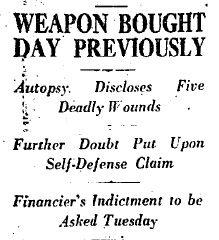
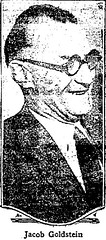 Joseph Stern, by bashing him four times over the head with a hammer and firing three bullets from a revolver into his body. It would have been less messy if only Goldstein had let an attorney handle the dissolution.
Joseph Stern, by bashing him four times over the head with a hammer and firing three bullets from a revolver into his body. It would have been less messy if only Goldstein had let an attorney handle the dissolution. 

 have feet as large as men’s are now”, said Mr.
have feet as large as men’s are now”, said Mr. 
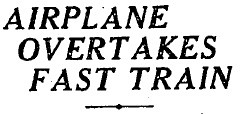





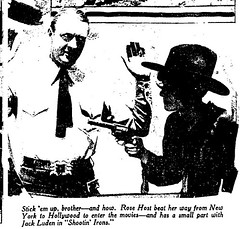 Luden. See – that’s Rose in the photograph, nothing more than a silhouette. Her part was so small she wasn’t even mentioned in the credits, and her Hollywood dreams ended with one picture. Rose Host the actress was not heard from again.
Luden. See – that’s Rose in the photograph, nothing more than a silhouette. Her part was so small she wasn’t even mentioned in the credits, and her Hollywood dreams ended with one picture. Rose Host the actress was not heard from again. 

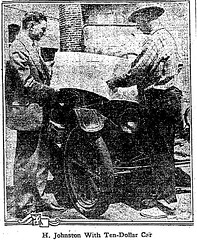



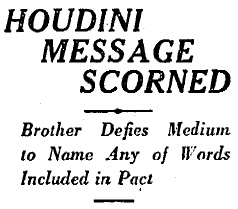
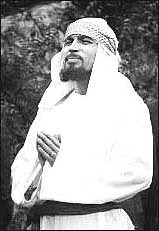 Egyptian mystic Hamid Bey claims to have received a message from deceased illusionist
Egyptian mystic Hamid Bey claims to have received a message from deceased illusionist 

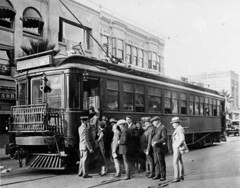
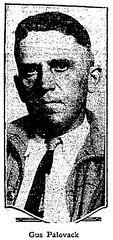 One of the most perplexing aspects of the case, other than why he chose a streetcar as his means of escape, is what drove Gus to bank robbery. Known about town as a realtor with political connections, Gus owns property and has several accounts in a number of downtown banks.
One of the most perplexing aspects of the case, other than why he chose a streetcar as his means of escape, is what drove Gus to bank robbery. Known about town as a realtor with political connections, Gus owns property and has several accounts in a number of downtown banks.